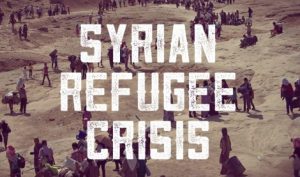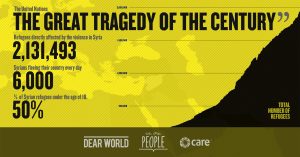Immigration Policy and The Syrian Refugee Crisis: Values, Ideology, and the Clash of Misinformation
By Vanessa Eddington | ISSUES
By Vanessa Eddington | ISSUES


The war in Syria has caused millions of people to flee their country in search of a safe place to reconstruct their lives. The Refugee Act that was passed in 1980 allows for the President of the United States to stipulate a certain number of refugees to be accepted into the country annually (Refugee Resettlement, 2016). Since the war erupted in Syria in 2011, thousands of refugees have migrated to the United States and Europe. The United States has a history of helping refugees from all over the world fleeing persecution and violence. Despite the opposition resettlement programs are facing in this era of terrorism in which we live right now, America is holding onto its ideals and values of freedom. Through federal funds that sustain refugee resettlement programs, the refugee population is being granted refuge in the United States.
The civil war that erupted in Syria in 2011 has forced millions of people to flee Syria and seek for refuge in various parts of the world including the United States. The war is now into its sixth year, and despite recent diplomatic initiatives, there seems to be no end in sight to the conflict. For the country’s 6 million refugees, returning to Syria remains a distant hope. (Clarke, 2016). According to Fabian (2016) the United States, in an effort to share this burden that the world is bearing, has accepted 10,000 refugees from Syria this year alone and Obama wants the nation to accept an additional 110,000 refugees from around the world next year. Not since World War II has the world been forced to deal with a refugee crisis on this scale; more than 65 million people have been driven from their homes, and 21 million have crossed international borders. (Fabian, 2016).
“Historically, refugees have been welcomed into the United States since the arrival of the pilgrims in 1620. Congress enacted the first refugee legislation in 1948, providing for the admission of Europeans displaced by World War II. Other laws passed in succeeding years allowed for the admissions of persons fleeing Communist regimes in Eastern Europe, Korea, China, and Cuba, as well as Indochinese displaced by the fall of Saigon and the end of the Vietnam War. (Congress Digest, 2016, p.1).

The conflict in Syria started in March 2011 in the city of Deraa after the arrest and torture of some teenagers who had painted revolutionary slogans on a school wall. Many took to the streets in pro-democracy protests and the national security open fired against them, killing many demonstrators. This caused more people to take the streets and by July 2011 hundreds of
thousands of people were protesting throughout the nation demanding President Assad’s resignation. (BBC News, 2016).
Those who were opposed began to take up arms, first to defend themselves and later to push government forces away from their communities, and as violence escalated a full blown civil war had been created, rebel brigades were formed to battle government forces that wanted to control the cities. By August 2015, according to BBC News, the number of people killed in the conflict was estimated to be 250,000 according to activists and the UN. (2016). The rise of the Islamic States of Iraq and Syria (ISIS) that emerged from Al-Qaeda in Iraq, joined the rebel group against President Bashar al-Assad harboring in Syria and taking advantage of the easy access to weapons. (BBC News, 2016).
According to Day & Schiele (2013) the American Judeo-Christian social value that equality for everyone must be achieved and those in need have the right to be helped. (p.10). In 1979 this social value was very explicit in the nature of the development of the Refugee Act of 1980, when Dick Clark, Ambassador and Coordinator for refugees affairs testified before the Senate in favor of proposed legislation that would become the 1980 Refugee Act. (Hamlin & Wolgin, 2012). He argued that the bill:
“acknowledges the size and diversity of current refugee populations by extending the definition of refugee beyond narrow geographic and ideological criteria. It essentially adopts the definition of the United Nations Protocol Relating to the status of refugees, to which we are a party.” (Hamlin & Wolgin, 2012 p.586).
The Refugee Act displays characteristics of liberalism in the sense that it advocates for fair distribution of resources, emphasizes the system and environment to analyze social problems, advocates on behalf of oppressed groups, and values government intervention in improving social and economic life. (Karger & Stoesz, 2014). However, Benson (2016) found that the Federal refugee policy was instituted in the 1980s at a time of neo-liberalization where market-oriented forces shifted policies in the United States. A more humanitarian and human rights narrative was replacing communist-centric concerns about refugee policy in the 1980s. We can see this neoliberal ideology when it comes to the care refugees are receiving. As stated by Moosa-Mitha (2016), in neoliberal times such as ours care for the refugees is being increasingly privatized through state policies.
Nevertheless, the refugee population definitely does not fit the American ideal, so the practice of otherism is evident. Moosa-Mitha (2016) found that this is the ideology that sets the climate for welfare services for refugees because of the discriminatory mentality that, those who are most like “us” or who can be regulated into being more like “us” are most deserving of public care and concern. Otherism is evidenced by the long history of exclusions that citizens have experienced on the basis of their difference/s from the ideal, White, breadwinner, male, able-bodied, and heteronormative citizen (Pharr, 1988). Moosa-Mitha (2016) also contend that the war on terror that countries in the global north are engaged in on Muslim-majority states has resulted in the treatment of the Muslim body as a threat. The proliferation of antiterrorist legislation across all welfare states, through heightened surveillance measures is evidence of this.
State policy and rhetoric, media pronouncements, and social responses to the “otherness” of Muslims living in our midst have become routinized, institutionalized, and normalized; and Islamaphobia is on the rise everywhere in nation-states of the global north (Moosa-Mitha, 2016). The acknowledgment of the existence of these ideologies provides important insights into the source and rationalization of these problems.
References
Benson, O. G. (2016). Refugee Resettlement Policy in an Era of Neoliberalization: A Policy Discourse Analysis of the Refugee Act of 1980. Social Service Review, 90(3), 515-549.
Clarke, K. (2016). The Politics of Refugee Relief. Dissent (00123846), 63(3), 94-101.
Day, P. J & Schiele, J. (2013). A new history of social welfare (7th ed.,pp. 13-14). Boston, MA: Pearson Education.
Fabian J. (2016) The Hill. NY attack hangs over Obama push for action on refugees. Retrieved from: http://thehill.com/homenews/administration/296739-ny-attack- hangs-over-obama-push-for-action-on-refugees.
Hamlin, R., & Wolgin, P. E. (2012). Symbolic Politics and Policy Feedback: The United Nations Protocol Relating to the Status of Refugees and American Refugee Policy in the Cold War. International Migration Review, 46(3), 586-624. doi:10.1111/j. 1747-7379.2012.00898.x
History of Refugee Resettlement in America. (2016). Congressional Digest, 95(1), 2-3.
Karger H.J. & Stoesz D. (2014). American social welfare policy: a pluralist approach. (7th ed.). Boston, MA: Pearson Education.
Moosa-Mitha, M. (2016). Geography of Care. Affilia: Journal of Women & Social Work. pp.281-284. doi:10.1177/0886109916658583.
Pharr, S. (1988). Homophobia : A weapon of sexism. NY : Womens Project.